This tutorial provides step-by-step instructions for building an N-Tier Windows Communication Foundation application from scratch using Trackable Entities.
Solution Creation
1. Create a new Trackable WCF Application
- Create a New Project, select the Trackable category, then choose Trackable WCF Application.
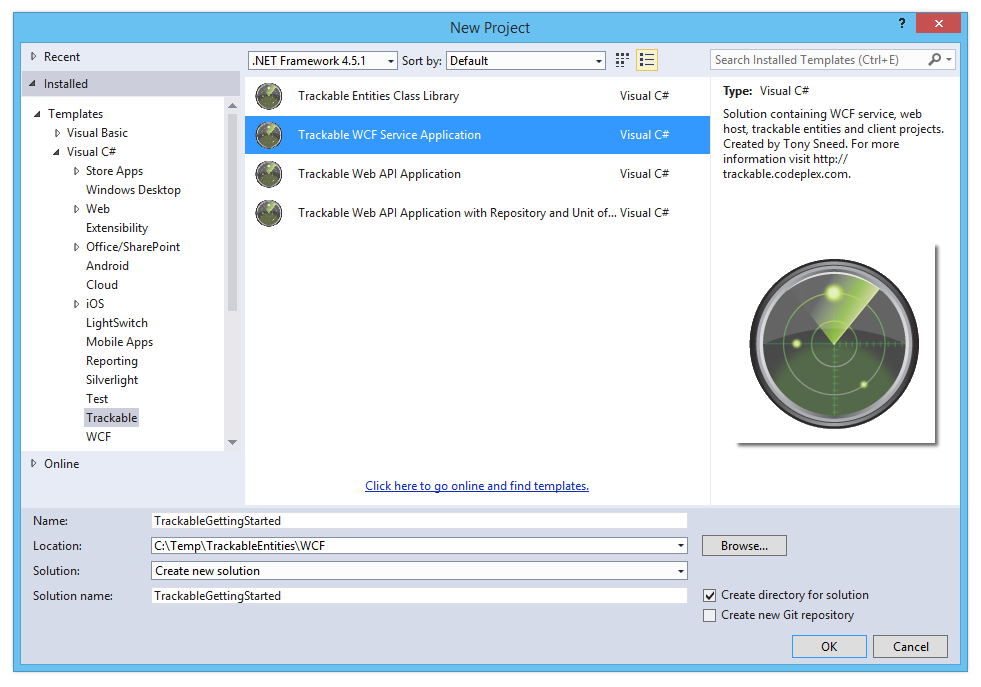
Solution Structure: The wizard will create a new Visual Studio solution with the following projects:
- ConsoleClient
- Entities.Client.Portable
- Entities.Service.Net45
- Core
- Web
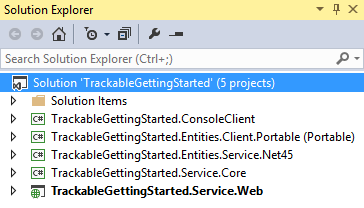
2. Choose the kinds of entities you would like to generate
Client / Service Entities: Generate separate entities for client and for service. Choose this option if you prefer entities which reflect a greater separation of concerns, for example, where client entities contain data binding and change tracking code but service entities do not.
Shared Entities: Generate shared entities in a .NET 4.5 class library that is shared between client and for service. Choose this option if you prefer shared code and less code duplication, for example, change tracking can be performed on both the client and service.
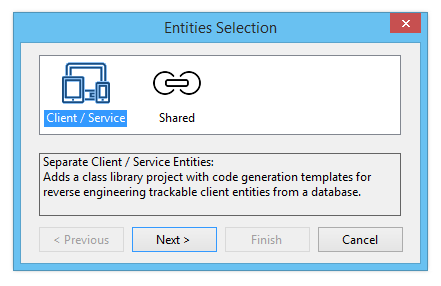
.NET 4.5 Entities: Generate entities for a .NET 4.5 Class Library so that they can be used by client applications based on .NET 4.5 or greater.
Portable Entities: Generate entities for a Portable Class Library so that they can be used by a variety of client applications, such as WPF, Windows Store, Windows Phone, iOS and Android. Note this option is available only for separate client / service entities.
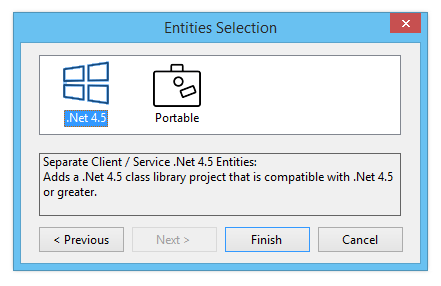
3. Update NuGet packages to the latest version
- Update Solution NuGet Packages: Right-click solution and select Manage NuGet packages for solution.
- Search for trackable, then update the Trackable Client, Common, and EF6 packages to the latest version.
- While you're at it, update the Entity Framework NuGet package to the latest 6.x version.

Entity Generation
Trackable entities are generated with EF designer tools using customizable T4 templates included with class library projects created by the Visual Studio wizard. T4 templates may be replaced using one of the available TrackableEntities.CodeTemplates NuGet packages.
4. Generate Entities with EF 6.x Tools for Visual Studio
Important: As of v2.5 Trackable Entities generates entities that are free of serialization attributes, therefore the [DataContract] attribute is no longer included. For this reason, if you select the option for separate client / service entities, each entities project will have the same default namespace. If you would like to add these projects manually, be sure that the default namespaces match.
Add an ADO.NET Entity Data Model to the Entities.Service.Net45 project. This option is also appropriate for shared entities.
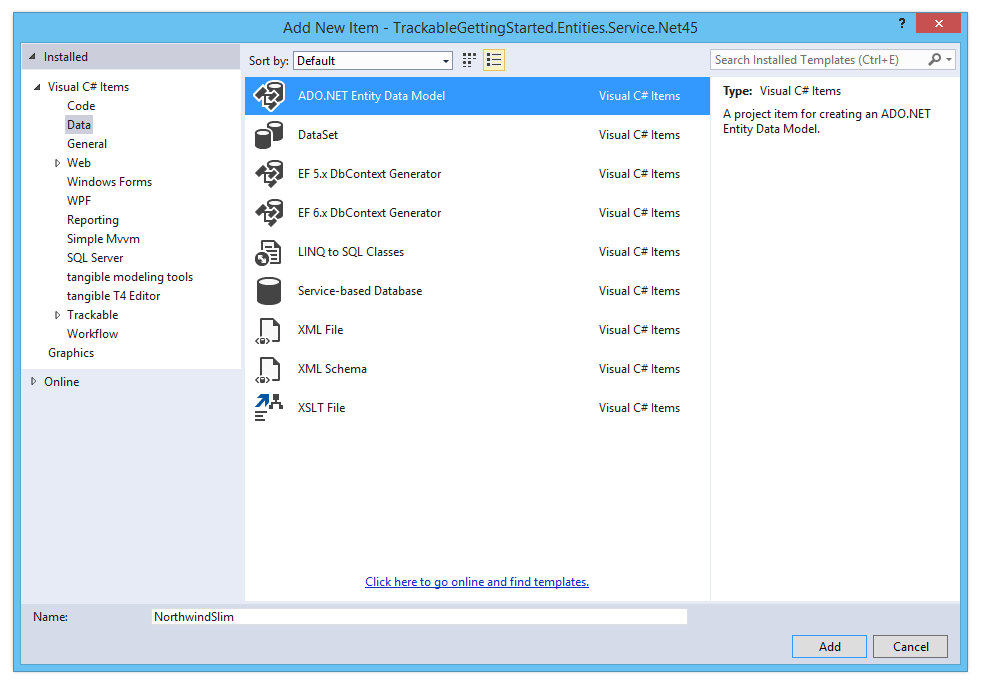
- Choose model contents: Select either EF Designer from database or Code First from database. Code first is recommended, as EDMX models will be deprecated in a future version of Entity Framework.
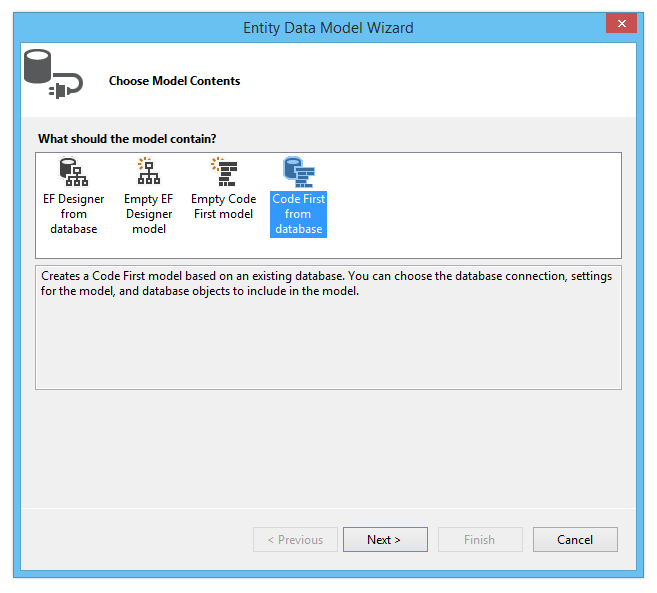
- Select or create a data connection: If necessary create a new data connection to the NorthwindSlim database for SQL Express. Make sure to install the prerequisites listed on the Trackable Entities installation page.
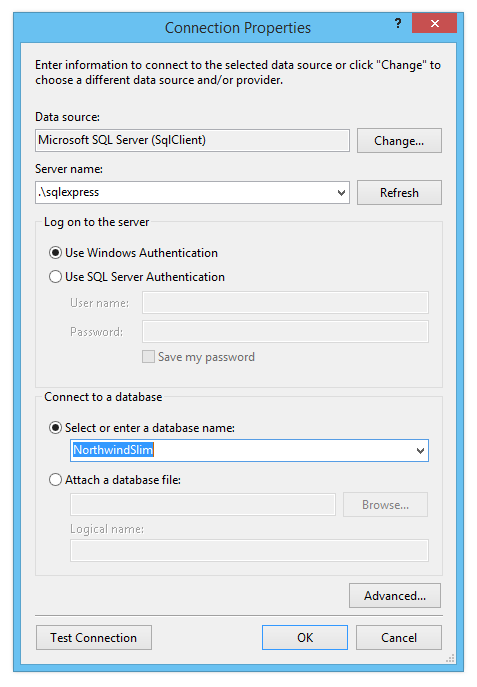
- Choose a data connection: Confirm choice of a data connection and the connection string name in App.Config.
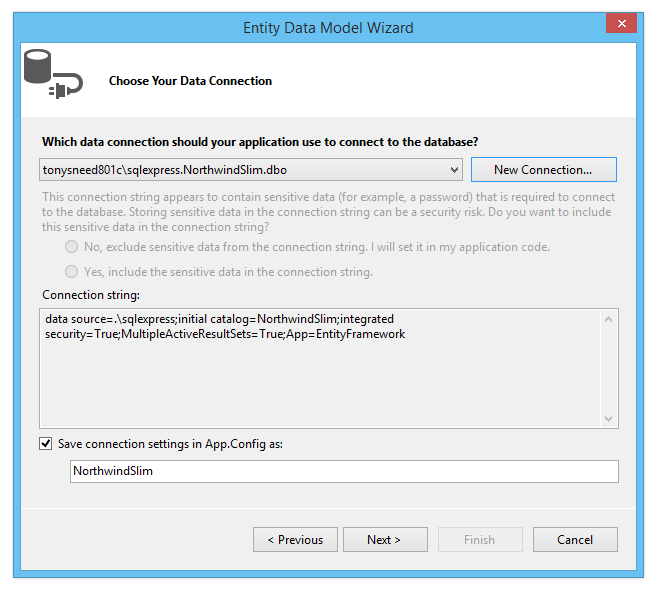
- Select tables: Select which tables you wish to use for generating entities.
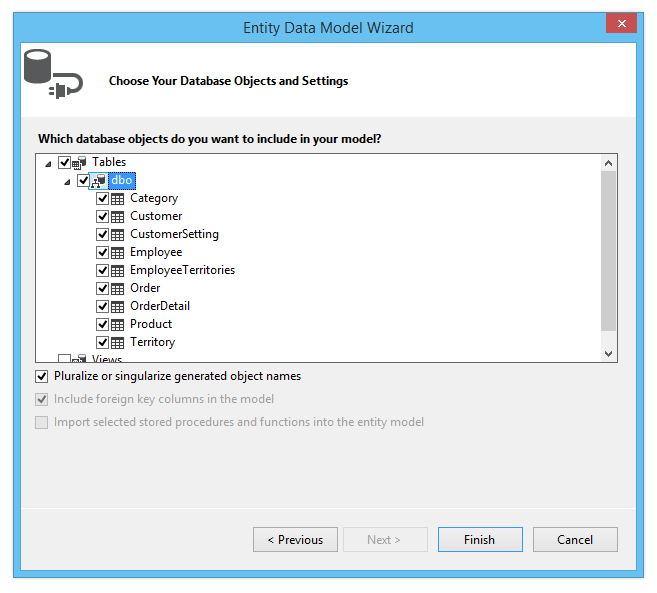
5. Generate Entities with EF Power Tools
- Select the Entities.Client.Portable project. If necessary, install the Entity Framework Power Tools according to instructions on the installation page.
- It's also possible to create client entities using the EF 6.x Tools for Visual Studio, but if a Portable Class Library is desired, you would first create a .NET 4.5 Class Library and then link to entity classes from the Entities.Client.Portable project.
- Right-click the Entities.Client.Portable project, select Entity Framework, then Reverse Engineer Code First.
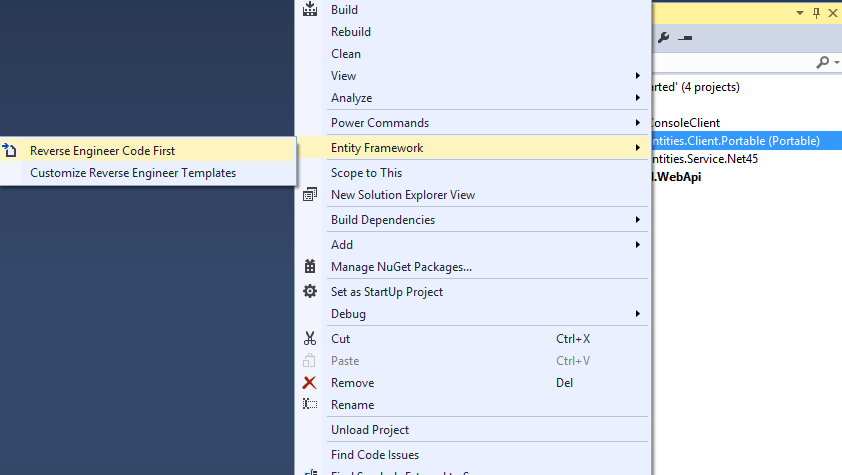
Important: After the EF Power Tools wizard has finished generating entities, delete both the NorthwindSlimContext.cs file and the Mapping folder.
Important: Because WCF requires that client and service entities share the same namespace, you should move the service entities into the Models folder and add .Models to the namespace for each entity class.
Build the solution.
WCF Service Types
In this part you'll add WCF service types to the Core project to perform CRUD operation (Create, Retrieve, Update and Delete) using trackable entities generated for the Entities.Service.Net45 project.
6. Copy Database Connection String to Web.Config
- Copy the database connection string from the App.config file of the Entities.Service.Net45 project to the connectionStrings section of the Web.config file of the Web project.
<connectionStrings>
<add name="NorthwindSlim" connectionString="data source=.\sqlexpress;initial catalog=NorthwindSlim;integrated security=True;MultipleActiveResultSets=True;App=EntityFramework" providerName="System.Data.SqlClient" />
</connectionStrings>
7. Add service types to the Core project
- Right-click the Core project and select Add New Item.
- Expand the Trackable category, then select the WCF sub-category, then choose Trackable WCF Service Type, and enter the name of an entity class with the Service suffix.
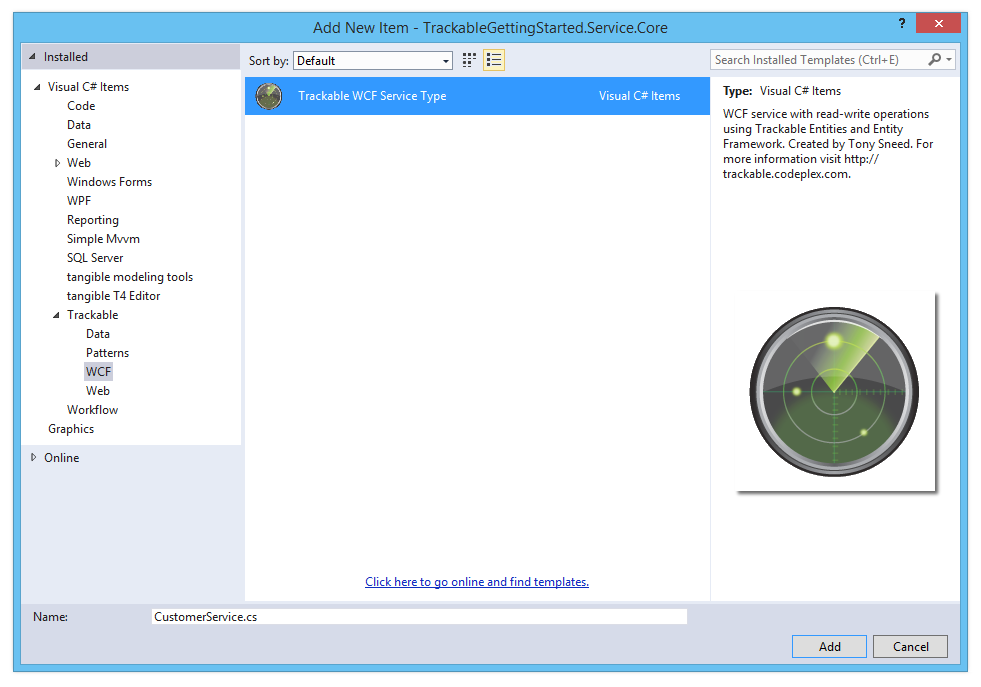
- Select an entity name from the dropdown list, type an entity set name, and select a DbContext name from the dropdown list.
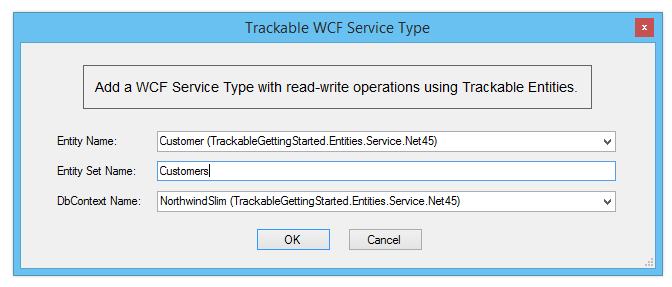
- If necessary, change the type for the primary key property, for example from
inttostring. Uncomment the
DataContractSerializerPreserveReferencesattribute in order to configure the serializer to handle cyclical references.The generated service class should resemble something like the following:
[DataContractSerializerPreserveReferences]
[ServiceContract(Namespace = "urn:trackable-entities:service")]
public interface ICustomerService
{
[OperationContract]
Task<IEnumerable<Customer>> GetCustomers();
[OperationContract]
Task<Customer> GetCustomer(string id);
[OperationContract]
Task<Customer> UpdateCustomer(Customer entity);
[OperationContract]
Task<Customer> CreateCustomer(Customer entity);
[OperationContract]
Task<bool> DeleteCustomer(string id);
}
- Now add an Order service type to the Core project.
- Add a
GetOrdersmethod that accepts acustomerIdparameter of typestringand filters orders by the specified customer id. - Update all the Get methods in to use the
Includeoperator for eager-loading Customer, OrderDetails, and Product properties. Note you'll want to use an overload ofIncludethat accepts astring, so that you can pass a dot-delimitted path for "OrderDetails.Product". This will fetch all the details for an order and will populate the products for each detail. - Also modify the Delete method to include order details:
.Include(e => e.OrderDetails)
[DataContractSerializerPreserveReferences]
[ServiceContract(Namespace = "urn:trackable-entities:service")]
public interface IOrderService
{
[OperationContract]
Task<IEnumerable<Order>> GetOrders();
[OperationContract]
Task<IEnumerable<Order>> GetCustomerOrders(string customerId);
[OperationContract]
Task<Order> GetOrder(int id);
[OperationContract]
Task<Order> UpdateOrder(Order entity);
[OperationContract]
Task<Order> CreateOrder(Order entity);
[OperationContract]
Task<bool> DeleteOrder(int id);
}
[ServiceBehavior(InstanceContextMode = InstanceContextMode.PerCall)]
public class OrderService : IOrderService, IDisposable
{
private readonly NorthwindSlim _dbContext;
public OrderService()
{
_dbContext = new NorthwindSlim();
}
public async Task<IEnumerable<Order>> GetOrders()
{
IEnumerable<Order> entities = await _dbContext.Orders
.Include(e => e.Customer)
.Include("OrderDetails.Product")
.ToListAsync();
return entities;
}
public async Task<IEnumerable<Order>> GetCustomerOrders(string customerId)
{
IEnumerable<Order> entities = await _dbContext.Orders
.Include(e => e.Customer)
.Include("OrderDetails.Product")
.Where(e => e.CustomerId == customerId)
.ToListAsync();
return entities;
}
public async Task<Order> GetOrder(int id)
{
Order entity = await _dbContext.Orders
.Include(e => e.Customer)
.Include("OrderDetails.Product")
.SingleOrDefaultAsync(e => e.OrderId == id);
return entity;
}
public async Task<Order> CreateOrder(Order entity)
{
entity.TrackingState = TrackingState.Added;
_dbContext.ApplyChanges(entity);
try
{
await _dbContext.SaveChangesAsync();
}
catch (DbUpdateException updateEx)
{
throw new FaultException(updateEx.Message);
}
await _dbContext.LoadRelatedEntitiesAsync(entity);
entity.AcceptChanges();
return entity;
}
public async Task<Order> UpdateOrder(Order entity)
{
_dbContext.ApplyChanges(entity);
try
{
await _dbContext.SaveChangesAsync();
}
catch (DbUpdateConcurrencyException updateEx)
{
throw new FaultException(updateEx.Message);
}
await _dbContext.LoadRelatedEntitiesAsync(entity);
entity.AcceptChanges();
return entity;
}
public async Task<bool> DeleteOrder(int id)
{
Order entity = await _dbContext.Orders
.Include(e => e.OrderDetails)
.SingleOrDefaultAsync(e => e.OrderId == id);
if (entity == null)
return false;
entity.TrackingState = TrackingState.Deleted;
_dbContext.ApplyChanges(entity);
try
{
await _dbContext.SaveChangesAsync();
return true;
}
catch (DbUpdateConcurrencyException updateEx)
{
throw new FaultException(updateEx.Message);
}
}
public void Dispose()
{
var dispose = _dbContext as IDisposable;
if (dispose != null)
{
_dbContext.Dispose();
}
}
}
- Build the solution.
8. Test the Web host
- Open the Web project in the solution explorer and rename ExampleService.svc to CustomerService.svc.
- Open the svc file and rename
ExampleServicetoCustomerService. - Copy CustomerService.svc. to OrderService.svc. and rename the service type in the same way.
- Right-click on each of the svc files in the Web project, and select View in Browser. You should see the service metadata help page displayed.
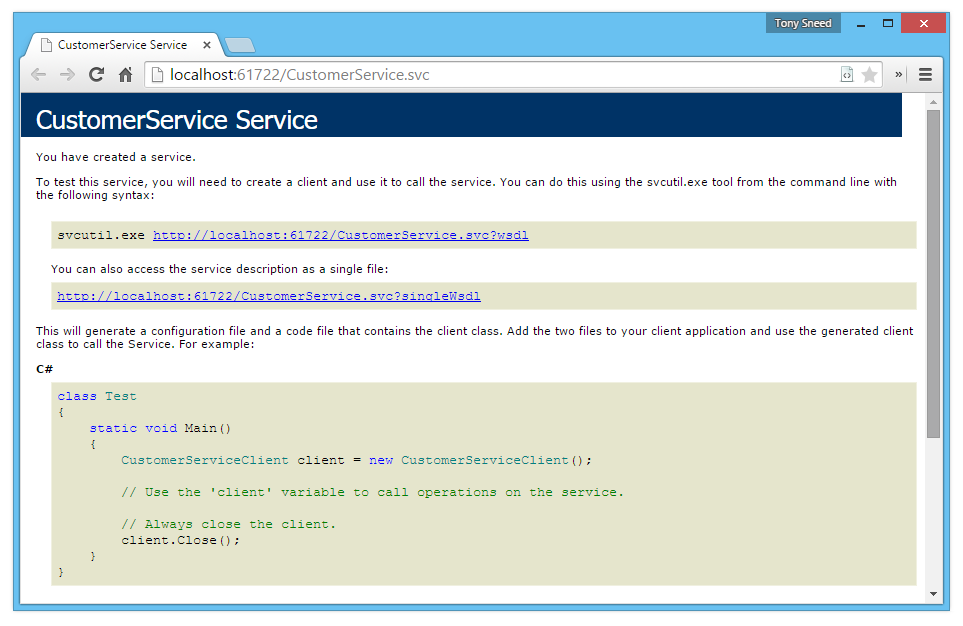
Retrieving Entities
Now that services have been added to the Core project and hosted in the Web project, it's time to configure the ConsoleClient to retrieve customers and orders from the WCF service.
9. Retrieve customers and orders
- Rename IExampleService.cs to match the service type interfaces from the Core project, for example:
ICustomerService,IOrderService. - Uncomment the code and update to match the service type interfaces from the Core project.
[ServiceContract(Namespace = "urn:trackable-entities:service")]
public interface ICustomerService
{
[OperationContract(Name = "GetCustomers")]
Task<IEnumerable<Customer>> GetCustomersAsync();
[OperationContract(Name = "GetCustomer")]
Task<Customer> GetCustomerAsync(int id);
[OperationContract(Name = "UpdateCustomer")]
Task<Customer> UpdateCustomerAsync(Customer entity);
[OperationContract(Name = "CreateCustomer")]
Task<Customer> CreateCustomerAsync(Customer entity);
[OperationContract(Name = "DeleteCustomer")]
Task<bool> DeleteCustomerAsync(int id);
}
- Repeat this for the order service type interface, and don't forget to include any methods you added to the service contract, such as
GetCustomerOrders.
[ServiceContract(Namespace = "urn:trackable-entities:service")]
public interface IOrderService
{
[OperationContract(Name = "GetOrders")]
Task<IEnumerable<Order>> GetOrdersAsync();
[OperationContract(Name = "GetCustomerOrders")]
Task<IEnumerable<Order>> GetCustomerOrdersAsync(string customerId);
[OperationContract(Name = "GetOrder")]
Task<Order> GetOrderAsync(int id);
[OperationContract(Name = "UpdateOrder")]
Task<Order> UpdateOrderAsync(Order entity);
[OperationContract(Name = "CreateOrder")]
Task<Order> CreateOrderAsync(Order entity);
[OperationContract(Name = "DeleteOrder")]
Task<bool> DeleteOrderAsync(int id);
}
- Copy the port number from the browser you used to test the WCF service, then paste it to replace the placeholder used for the port number in App.config. Uncomment the endpoint section, then rename Example to Customer. Copy the endpoint for Order.
- You may also wish to increase the maxReceivedMessageSize and maxBufferSize parameters of the basicHttpBinding configuration to increase their values.
<system.serviceModel>
<bindings>
<basicHttpBinding>
<binding maxReceivedMessageSize="2147483647"
maxBufferSize="2147483647">
</binding>
</basicHttpBinding>
</bindings>
<client>
<endpoint address="http://localhost:50198/CustomerService.svc"
binding="basicHttpBinding"
contract="TrackableGettingStarted.ConsoleClient.ICustomerService"
name="customerService">
</endpoint>
<endpoint address="http://localhost:50198/OrderService.svc"
binding="basicHttpBinding"
contract="TrackableGettingStarted.ConsoleClient.IOrderService"
name="orderService">
</endpoint>
</client>
</system.serviceModel>
- Uncomment code in
Program.Mainto retrieve customers from the WCF service and print them to the console. - Also uncomment the Helper methods in
Program.
class Program
{
private static void Main(string[] args)
{
// Main method
Console.WriteLine("Press Enter to start");
Console.ReadLine();
ICustomerService customerService = new ChannelFactory<ICustomerService>("customerService").CreateChannel();
IOrderService orderService = new ChannelFactory<IOrderService>("orderService").CreateChannel();
using ((IDisposable) customerService)
using ((IDisposable) orderService)
{
try
{
// Get customers
Console.WriteLine("Customers:");
IEnumerable<Customer> customers = customerService.GetCustomersAsync().Result;
if (customers == null) return;
foreach (var c in customers)
PrintCustomer(c);
// Get orders for a customer
Console.WriteLine("\nGet customer orders {CustomerId}:");
string customerId = Console.ReadLine();
if (!customers.Any(c => string.Equals(c.CustomerId, customerId, StringComparison.OrdinalIgnoreCase)))
{
Console.WriteLine("Invalid customer id: {0}", customerId.ToUpper());
return;
}
IEnumerable<Order> orders = orderService.GetCustomerOrdersAsync(customerId).Result;
foreach (var o in orders)
PrintOrder(o);
// Get an order
Console.WriteLine("\nGet an order {OrderId}:");
int orderId = int.Parse(Console.ReadLine());
if (!orders.Any(o => o.OrderId == orderId))
{
Console.WriteLine("Invalid order id: {0}", orderId);
return;
}
Order order = orderService.GetOrderAsync(orderId).Result;
PrintOrderWithDetails(order);
// TODO: Create an order, then update and delete it
}
catch (AggregateException aggEx)
{
var baseEx = aggEx.Flatten().GetBaseException();
var innerExMsg = baseEx.InnerException != null ? "\r\n" + baseEx.InnerException.Message : "";
Console.WriteLine(baseEx.Message + innerExMsg);
}
finally
{
var channel = customerService as IClientChannel;
if (channel != null && channel.State == CommunicationState.Faulted)
{
channel.Abort();
}
}
// Keep console open
Console.WriteLine("Press any key to exit");
Console.ReadKey(true);
}
}
}
- With the Web service still running, you can set ConsoleClient as the solution Startup Project, then press Ctrl+F5 to run it. You should see a list of customers from the NorthwindSlim database printed to the console.
Updating Entities
Next we'll add code to ConsoleClient for creating a new order, then updating the order by adding, removing and deleting details. Lastly, we'll delete the order we created and confirm that it was in fact deleted.
10. Create an order
- Create a new order with details. Populate the foreign key values for the
CustomerIdproperty of the order, as well asProductIdfor each detail.
// Create a new order
Console.WriteLine("\nPress Enter to create a new order for {0}", customerId.ToUpper());
Console.ReadLine();
var newOrder = new Order
{
CustomerId = customerId,
OrderDate = DateTime.Today,
ShippedDate = DateTime.Today.AddDays(1),
OrderDetails = new ChangeTrackingCollection<OrderDetail>
{
new OrderDetail { ProductId = 1, Quantity = 5, UnitPrice = 10 },
new OrderDetail { ProductId = 2, Quantity = 10, UnitPrice = 20 },
new OrderDetail { ProductId = 4, Quantity = 40, UnitPrice = 40 }
}
};
var createdOrder = orderService.CreateOrderAsync(newOrder).Result;
PrintOrderWithDetails(createdOrder);
11. Update the order and details
- Start change tracking the order by adding it to a new
ChangeTrackingCollection. - Add a new detail, modify an existing detail, then remove a detail. Leave one detail unchanged.
- Call
GetChangeson the change tracker to obtain only items which have been added, updated or deleted. This will help us avoid sending unchanged entities to the service. - After sending changes to the service PUT operation for updating, call
MergeChangeson the change tracker, passing the updated order returned by the PUT operation. This will ensure that database-generated values (for example identity and concurrency) will be merged back into the original object graph.
// Update the order
Console.WriteLine("\nPress Enter to update order details");
Console.ReadLine();
// Start change-tracking the order
var changeTracker = new ChangeTrackingCollection<Order>(createdOrder);
// Modify order details
createdOrder.OrderDetails[0].UnitPrice++;
createdOrder.OrderDetails.RemoveAt(1);
createdOrder.OrderDetails.Add(new OrderDetail
{
OrderId = createdOrder.OrderId,
ProductId = 3,
Quantity = 15,
UnitPrice = 30
});
// Submit changes
Order changedOrder = changeTracker.GetChanges().SingleOrDefault();
Order updatedOrder = orderService.UpdateOrderAsync(changedOrder).Result;
// Merge changes
changeTracker.MergeChanges(updatedOrder);
Console.WriteLine("Updated order:");
PrintOrderWithDetails(createdOrder);
12. Delete the order and confirm that delete was successful
- To delete the order, we simply pass the
OrderIdto the DELETE service operation. - To confirm that the delete was successful, simply call GET and pass the id of the deleted order. The operation will return null if the order was deleted.
// Delete the order
Console.WriteLine("\nPress Enter to delete the order");
Console.ReadLine();
bool deleted = orderService.DeleteOrderAsync(createdOrder.OrderId).Result;
// Verify order was deleted
Order deletedOrder = orderService.GetOrderAsync(createdOrder.OrderId).Result;
Console.WriteLine(deleted && deletedOrder == null
? "Order was successfully deleted"
: "Order was not deleted");